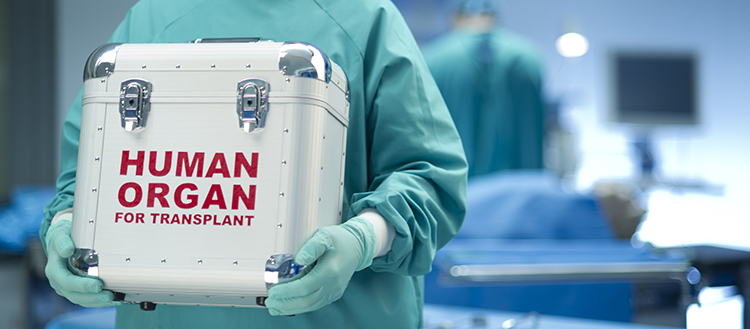One out of every two transplant recipients at risk of infection
Swiss researchers, including UNIGE, show that 50% of transplant recipients develop severe infections within a year of the operation, which can lead to death.

©All rights reserved
A group of Swiss researchers, under the direction of the University Hospitals of Geneva (HUG), the University of Geneva (UNIGE) and the University Hospital of Zurich, show that more than 50% of patients who have received an organ transplant may develop severe infections - of bacterial origin in 60% of cases - in the first year after the transplant. Although the number of multi-resistant bacterial infections is fortunately low at the moment in Switzerland, the trend is very alarming in view of the progression of antibiotic resistance worldwide. This research can be read in Clinical Infectious Diseases.
Organ transplantation remains the only chance of survival for patients with end-stage organ disease. Every year in Switzerland, 600 people receive a heart, kidney, liver, lungs or pancreas. Today more than 5,000 patients live in Switzerland thanks to one or more transplanted organs. In order to avoid any risk of rejection, these patients must take immunosuppressive drugs throughout their lives, which make them particularly vulnerable to infections (bacterial, viral or fungal), especially in the twelve months following the operation, when the immunosuppressive drugs are at their highest doses. Since the 1980s, antibiotic, antiviral, and antifungal prophylaxis are prescribed to these patients to protect them from certain opportunistic pathogens, including cytomegalovirus, toxoplasma and pneumocystis.
“So far no studies were available to identify infections in patients undergoing prophylaxis," says Christian van Delden, Professor at the UNIGE Faculty of Medicine and Head of the Transplantation Infectious Diseases Unit at the HUG, who co-directed the work. But the prevailing impression was that the risk of infection gradually decreases from the second month onwards, in parallel with the progressive decrease in immunosuppressive drugs, which nevertheless can never be totally stopped". Such a study is therefore crucial to precisely determine the effectiveness of current prophylaxis and to define new ways of improving the care of these particularly vulnerable patients.
A monitoring of exceptional scope
Almost 3,000 people were included in the study, which ran from 2008 to 2014, i.e. almost all transplant patients in Switzerland, as part of the Swiss Transplant Cohort Study (STCS). Financed by the National Science Foundation, the country's main hospitals and the Federal Office of Public Health, this cohort has been monitoring transplant patients, particularly for infectious complications, since 2008 for the purposes of research and standardisation of care. “The main aim is to improve the quality of life and survival of our patients," says Professor Nicolas Müller of the University Hospital Zurich, president of the scientific board of the STCS.
What does this follow-up reveal? The prophylaxis is efficient to prevent cytomegalovirus, toxoplasma and pneumocystis infections, which have become rare. However, more than 50% of the patients still experienced one or more severe infections due to other pathogens, with different vulnerabilities depending on the type of organ transplant. The patients most at risk in the weeks following the transplant are those who received a heart or lungs. Afterwards, lung transplant recipients remain very vulnerable to infection. On the other hand, patients who have received a kidney remain relatively less at risk for serious infections. The types of pathogens involved have also been determined: more than 60% of infections are bacterial, usually caused by enterobacteria, intestinal bacteria that tend to develop resistance to antibiotics. Of notice, most infections affect the transplanted organ itself.
“In order to ensure adequate prophylaxis and follow-up, we must therefore take into account the chronology, the type of transplanted organ and the bacteria most often involved, explains Christian van Delden, co-founder of the STCS. Our work has thus enabled us to establish some guidelines for MDs." The prevention of infections in transplant patients is a major challenge in view of the worldwide increase in antibiotic resistance, and calls for improved surgical techniques and the development of new therapies that are less likely to encourage the emergence of multi-resistant bacteria.
A study unique in the world
In most countries, the distances between transplant centers and patients' homes are too important to allow accurate monitoring of infectious complications after transplantation. In Switzerland, on the other hand, these distances are small and patient follow-up is carried out by the transplant centers themselves, which are the university hospitals of Bern, Basel, Geneva, Lausanne and Zurich, as well as the cantonal hospital of St. Gallen. Its high medical density and its geographical specificities make Switzerland a unique country for the follow-up of these patients throughout their lives.
This study, the largest published to date in the field, was carried out by a group of researchers including experts in transplantation infectiology from all Swiss centers (H. Hirsch, M. Weisser and N. Khanna from Basel, O. Manuel and P. Meylan from Lausanne, A. Cusini, C. Garzoni and C. Hirzel of Berne, K. Boggian of St. Gallen, D. Nadal and C. Berger of Zurich).
9 Jan 2020